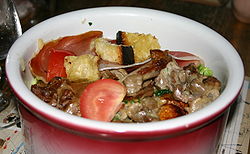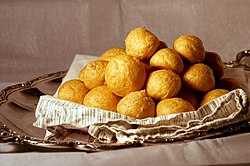French cuisine
French cuisine is characterized by its extreme diversity. French cuisine is considered to be one of the world's most refined and elegant styles of cooking, and is renowned for both its classical ("haute cuisine") and provincial styles. Many of the world's greatest chefs, such as Taillevent, La Varenne, Carême, Escoffier, and Bocuse, are or were masters of French cuisine. Additionally, French cooking techniques have been a major influence on virtually all Western cuisines, and almost all culinary schools use French cuisine as the basis for all other forms of Western cooking.
Diversity
Traditionally, each region of France has its own distinctive cuisine:
- Cuisine from northwest France uses butter, cream, and apples;
- Cuisine from southwest France uses duck fat, foie gras, porcini mushrooms, and gizzards;
- Cuisine from southeast France uses olive oil, herbs, and tomatoes, and shows deep influences from Spanish cuisine, Catalan cuisine and Italian cuisine .
- Cuisine from northern France uses potatoes, pork, endives and beer, and shows Flemish cuisine influences.
- Cuisine from eastern France uses lard, sausages, beer, and sauerkraut, and shows German cuisine influences.
Besides these five general areas, there are many more local cuisines, such as Loire Valley cuisine, Basque cuisine and the cuisine of Roussillon, which is similar to Catalan cuisine. With the movements of population of contemporary life, such regional differences are less noticeable than they used to be, but they are still clearly marked, and one traveling across France will notice significant changes in the ways of cooking and the dishes served. Moreover, recent focus of French consumers on local, countryside food products means that the regional cuisines are experiencing a strong revival in the early 21st century, especially as the slow food movement is gaining popularity.
What is often known outside of France as French cuisine is the traditionally elaborate haute cuisine, served in restaurants for high prices. This cuisine is mostly influenced by the regional cuisines of Lyon and northern France, with a marked touch of refinement. Average French people do not eat or prepare this cuisine in their everyday life. As a general rule, elderly people tend to eat the regional cuisine of the region where they are located, while younger people will be more inclined to eat dishes from other regions and foreign dishes. Exotic cuisines, particularly Chinese cuisine and Vietnamese cuisine and some dishes from former colonies in Northern Africa have made inroads.
French wine and French cheese are an integral part of French cuisine, both as ingredients and accompaniments. France is known for its large ranges of wines and cheeses.
Ingredients
French regional cuisine uses locally grown vegetables, such as these:
- potatoes
- green beans
- carrots
- leeks
- turnips
- aubergine (also known as eggplant)
- courgette (also known as zucchini)
- Mushrooms, oyster mushrooms, Porcinis, truffles, and other vegetables, in order of increasing rarity and price.
Common fruits include:
- oranges
- tomatoes
- tangerines
- peaches
- apricots
- apples
- pears
- plums
- cherry
- strawberry
- raspberry
- redcurrant
- blackberry
- grape
- blackcurrant
Meats commonly consumed include:
Horse meat is available from special butcher stores, but few people consume it.
Seafood commonly consumed includes:
Fresh fruit and vegetables, as well as fish and meat, are purchased either from supermarkets and grocery stores or smaller markets Street markets are held on certain days in most localities; towns of a certain importance generally have a more permanent covered market in which food shops, especially meat and fish retailers, have better shelter than the periodic street markets. Generally, a street market for vegetables takes places on certain days outside such covered markets.
Present-day food and drink in France
For French people, cooking is a part of culture, and cooking good food is well appreciated. The French generally take a high pride in the cuisine of their country, and some, particularly in the older generations, are reluctant to experiment with foreign dishes.
Structure of meals
Breakfast
The normal day begins with a light breakfast in the morning, generally consisting of:
- bread with jam and spreads, often replaced nowadays by breakfast cereals,
- a hot drink such as coffee, tea or chocolate flavored milk,
- viennoiseries (not as a rule, see below),
- some fruit or fruit juice.
Hotel breakfasts often contain croissants, but it is uncommon for french people to eat croissants at every breakfast. Indeed, they are mainly eaten on weekends, when people have time to go to their baker's and buy fresh viennoiseries before eating breakfast. Croissants may be replaced with other kinds of viennoiserie such as pains au chocolat, madeleines etc.
Typical lunch and dinner
Lunch is had at some point between noon and 2 p.m., and dinner in the evening after 7:00 p.m. However there are large variations depending on the local regional cultures. The dinner is usually between 6 p.m and 7:30 p.m in northern France for example while it is usually after 8:30 p.m in southern France. It is light in the North and rather heavy and important in the South. A normal complete meal consists of:
- appetizers, often consisting of crudités, or a salad
- a main dish, usually meat or fish with a side of vegetables, pasta, rice, or fries
- salad (absolutely not compulsory)
- some cheese
- dessert: yoghurt, fruit or cake
Meals, particularly lunch, are often followed by a tiny cup of coffee.
Alcoholic products may be consumed as follows:
- The meal may be preceded by an apéritif, for example some dose of flavoured Vermouth or region-specific drinks and cocktails such as Pastis (south) or Kir (north).
- Wine is often drunk with the meal. Occasionally, people consume beer though the frequency depends on the region of the country. Typically, wine or beer is chosen to match with the food; festive meals will typically accompany each dish with a different wine.
- The meal may be followed by a digestif — some small dose of liqueur or other high alcoholic spirit.
In most cities, street markets sell fresh vegetables, meat and fish, and evening or weekend meals are very often cooked with fresh ingredients.
Variations
Festive meals may include several main dishes. Some meals incorporate a trou normand — some small dose of a highly alcoholic liquor or sorbet, perhaps calvados, which props up appetite for what follows.
In large cities a majority of working people and students eat their lunch at a corporate or school cafeteria, which normally serve complete meals as described above; it is therefore not usual for students to bring their own lunch food. It is common for white-collar workers to be given lunch vouchers as part of their employee benefits. These can be used in most restaurants, supermarkets and delis; however workers having lunch in this way typically do not eat all three dishes of a traditional lunch due to price and time considerations. In smaller cities and towns, some working people leave their workplaces to return home for lunch, generating four rush hours during the day. Finally, an also popular alternative especially among blue-collar workers is to lunch on a sandwich possibly followed with a dessert; both dishes can be found ready-made at bakeries and supermarkets for budget prices.
Drink
Traditionally, France has been a culture of wine consumption. While this characteristic has lessened with time, even today, many French people drink wine daily. The consumption of low-quality wines during meals has been greatly reduced. Beer is especially popular with the youth. Other popular alcoholic drinks include pastis, an aniseed flavoured beverage drunk diluted with cold water, or cider.
The legal alcohol purchase age is 16. Usually, parents tend to prohibit their children from consuming alcohol before these children reach their early teens. Students and young adults are known to drink heavily during parties, but usually drunkenness is not displayed in public. Public consumption of alcohol is legal, but driving under the influence can result in severe penalties.
Divisions of Restaurant Cuisine
Schematically, French restaurant cuisine can be called as Cuisine bourgeoise, which includes all the classic French dishes which are not or no longer specifically regional, and which have been adapted over the years to suit the taste of the affluent.
Notable Dishes
Famous French Dishes
- Blanquette de veau
- Boeuf à la mode
- Canard au sang
- Coq au Vin
- French Cheese
- Navarin
- Oysters
- Pot-au-feu
- Steak au poivre
- Soufflé
For the southwestern part:
For the southeastern mediterranean part:
For the eastern central part (alps, rhone valley...):
For the northwestern part (Birtanny, Normandy ...):
For the NorthEastern part (Alsace, Lorraine ...):
- Potée lorraine, Quiche, Choucroute Garnie, Fondue bourguignonne (not to be mistaken with the Cheese Fondue- this dish is actually a part of Savoyarde (which is in France) and Swiss cuisine)
Quick Food
The following dishes can generally be ordered in brasseries:
- Steak frites-steak with fries; fries can often be replaced by string beans
- Poulet frites-chicken with fries
- Croque-monsieur-a grilled Swiss cheese and ham sandwich
Generally speaking, fries are a common side order for lower end French style restaurants. The French generally consider fries to be of Belgian origin, although there is no evidence for this; a typically Belgian dish is steamed mussels with a side of fries.
A typical simple, cheap, quick meal consists of pasta, often spaghetti, with tomato sauce.
Common Canned Food
Most dishes, including relatively sophisticated ones, are available as canned or frozen food in supermarkets. These products are sometimes endorsed by famous chefs.
Common Savory Pies
- Tarte flambée from Alsace
- Flamiche from Artois and Picardy
- Quiche from Lorraine
- Pissaladière from Nice
Famous But Atypical Dishes
The following dishes are considered typical of French cuisine in some foreign countries, but actually are rarely eaten in France:
Desserts
- Crêpes, a speciality of Brittany
- Chocolate Mousse
- Pastries
- Mille-feuille
- Choux a la creme
Specialties by region/city


- Alsace:
- Choucroute garnie (sauerkraut with sausages, salt pork and potatoes)
- Spätzle
- Baeckeoffe
- Kouglof
- Bredela
- Beerawecka
- Mannala
- Alps
- Raclette (the cheese is melted and served with potatoes, ham and often dried beef)
- Fondue savoyarde (fondue made with cheese and white wine into which cubes of bread are dipped)
- Gratin dauphinois
- Tartiflette (a Savoyard gratin with potatoes, Reblochon cheese, cream and pork)
- Artois-Picardy:
- andouillette of Cambrai
- Carbonnade (meat stewed in beer)
- Potjevlesch (a four-meat terrine)
- Waterzoï (a sweet water fish stew)
- Escavêche (a cold terrine of sweet water fish in wine and vinegar)
- Hochepot (four meats stewed with vegetables)
- Auvergne:
- Tripoux (tripe 'parcels' in a savoury sauce)
- Truffade (potatoes sautéed with garlic and young Tomme cheese)
- Aligot (mashed potatoes blended with young Tomme cheese)
- Pansette de Gerzat (lamb tripe stewed in wine, shallots and blue cheese)
- Brittany:
- Crêpes
- Far Breton (a flan with prunes)
- Kik ar Fars (boiled pork dinner with a kind of dumpling)
- Kouign amann (a type of galette made flakey by a very high proportion of butter)

- Burgundy:
- Boeuf Bourguignon (beef stewed in red wine)
- Escargots de Bourgogne (snails baked in their shells with parsley butter)
- Fondue bourguignonne (fondue made with oil in which pieces of meat are cooked)
- Gougère (cheese in chou pastry)
- Pochouse (fish stewed in red wine)
- Côte d'Azur/Provence:
- Bouillabaisse (a stew of mixed Mediterranean fish, tomatoes, and herbs)
- Ratatouille (a vegetable stew with sautéed aubergine, asparagus, yellow squash, bell peppers, tomato and basil)
- Pieds paquets Lambs' feet and tripe 'parcels' in a savoury sauce
- Southwest:
- Salade landaise
See also
- Antoine Carême
- Auguste Escoffier
- French paradox
- List of recipes
- List of French cheeses
- Larousse Gastronomique
External links
- Provençal Cuisine Guide and Recipes
- Provence-Hideaways Provençal Cuisine(cheesburger)
